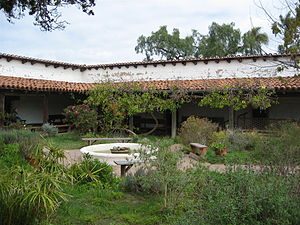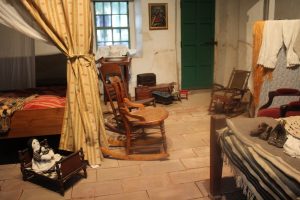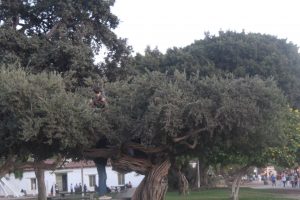 On our last trip to San Diego, we were wandering around Old Town and purely by accident we ended up at the place in which a pivotal scene in Ramona, by Helen Hunt Jackson, takes place. You can’t actually stay there, but it’s a lovely spot to wander around in and I can personally vouch for the general area (Old Town San Diego) as a romantic place to spend time right around twilight, when it’s neither too hot nor too cold, and not too crowded or too empty.
On our last trip to San Diego, we were wandering around Old Town and purely by accident we ended up at the place in which a pivotal scene in Ramona, by Helen Hunt Jackson, takes place. You can’t actually stay there, but it’s a lovely spot to wander around in and I can personally vouch for the general area (Old Town San Diego) as a romantic place to spend time right around twilight, when it’s neither too hot nor too cold, and not too crowded or too empty.
Ramona is a well-intentioned novel that is a tortuous read today. Helen Hunt Jackson had previously written a non-fiction book, A Century of Dishonor, about the mistreatment of Native Americans by the American government. It was well researched but dry. She hoped to write a novel that would humanize the plight of Native Americans, much like Uncle Tom’s Cabin had made white people more concerned about slavery. The book, Ramona, was published in 1884 and was a huge success, but not for the reasons Jackson had hoped.
Instead of worrying about Native Americans, readers fixated on the lyrical and idealized description of the last years of Mexican Colonial life. Jackson’s portrayal of Native Americans was well intentioned, but is patronizing and relies on “noble savage”

stereotypes. In that regard, it’s almost unbearable to try to read today, and I do not recommend it. However, Jackson’s descriptive powers of daily life on a ranch and of the scenery in Southern California are amazing, and there is a genuinely powerful and tragic love story to be found (two, depending on how you feel about the ending).
People became fascinated by this idealized time in which the Spanish, and then Mexicans, held California as a colony. Everyone wanted to visit the locations in Ramona, which was tricky, since most were not named. Of course, if the locations were not named, then anyone who wanted tourist dollars could claim to be the site of this or that event in the book.
The most famous was La Casa de Estudillo. This structure was built sometime around 1830 as a home for the Estudillo Family. They needed a big place since they had twelve biological children and adopted more. The building was most likely constructed by Kumeyaay people, who worked at the Casa as servants, vaqueros, and sheepherders.

In Ramona, Ramona falls in love with a Kumeyaay sheepherder, one who is so skilled at his job that Ramona’s family won’t start shearing their sheep until he can come and lead the effort. In the book, they run away to get married, and are married by a priest at a building that seems a lot like the Casa de Estudillo.
Whether the Casa is the place Jackson pictured in her book or not, it sure is pretty. There’s a garden outside with a little fountain. It’s a good place for butterflies. The building is made up of rooms in a U-shape, with the garden at the center. The rooms are arranged so that you can peek inside them, which is fun. There is a State Law that no old dwelling in California may exist without a minimum of one creepy doll and one alleged ghost. I’m pleased to report that The Casa does fulfill this requirement.

Outside the Casa there’s a park that features a child tree. I’m no botanist, but I assume it’s a child tree because when I was there it was full of children in the same way that orange trees are full of oranges. Sometimes a few children would plop down onto the ground. I presume that’s how you know if they are ripe. If one child came down another immediately went up, and thus the great circle of life continued seamlessly and is probably still continuing seamlessly at this very moment.

There’s a square nearby with live music and a lot of food. You can get fancy Mexican food, or churros, or fancy churros. Also, you can buy a copy of Ramona.
The book Ramona is a hot mess that glorifies the incredibly oppressive Mission system. However, it did leave us with some beautiful images and with enough interest in La Casa Estudillo that it has stayed more or less intact all this time. I don’t recommend reading Ramona, but I do recommend exploring the Casa and the rest of Old Town San Diego, at twilight, with a churro and a person you adore. If you don’t have access to anyone you adore, the churro will more than suffice.


Great write-up, Carrie. One more reason to visit San Diego. I can remember reading Ramona as a history addicted preteen. Oh, the atmosphere and the romance! However, I have had no desire to re-read it in the 50+ years since then.
The child tree provided my best laugh of the morning, thank you for that.